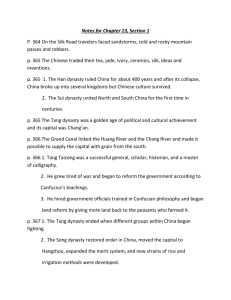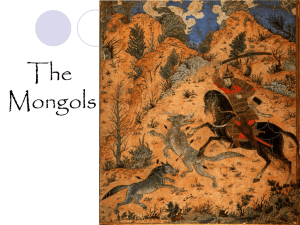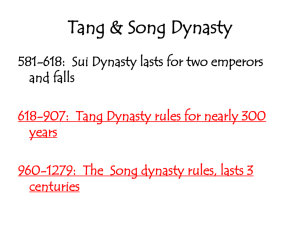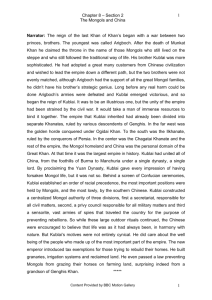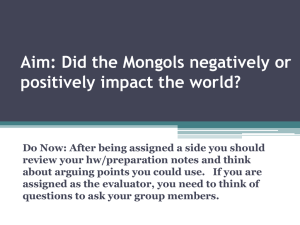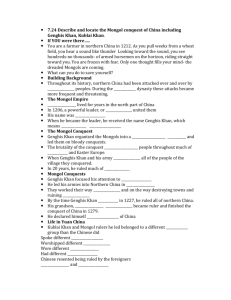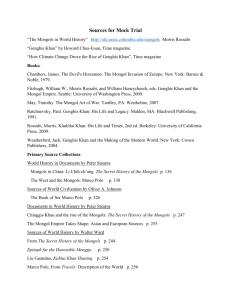Chapter 12 Reading Guide
advertisement
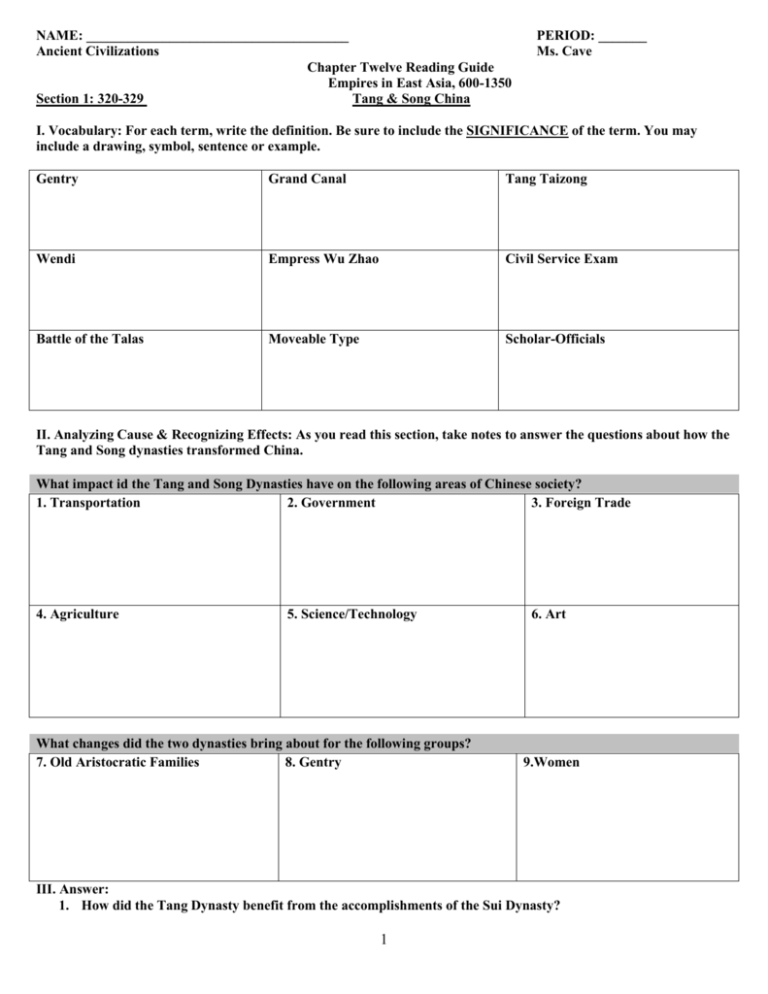
NAME: ______________________________________ Ancient Civilizations Chapter Twelve Reading Guide Empires in East Asia, 600-1350 Section 1: 320-329 Tang & Song China PERIOD: _______ Ms. Cave I. Vocabulary: For each term, write the definition. Be sure to include the SIGNIFICANCE of the term. You may include a drawing, symbol, sentence or example. Gentry Grand Canal Tang Taizong Wendi Empress Wu Zhao Civil Service Exam Battle of the Talas Moveable Type Scholar-Officials II. Analyzing Cause & Recognizing Effects: As you read this section, take notes to answer the questions about how the Tang and Song dynasties transformed China. What impact id the Tang and Song Dynasties have on the following areas of Chinese society? 1. Transportation 2. Government 3. Foreign Trade 4. Agriculture 5. Science/Technology What changes did the two dynasties bring about for the following groups? 7. Old Aristocratic Families 8. Gentry 6. Art 9.Women III. Answer: 1. How did the Tang Dynasty benefit from the accomplishments of the Sui Dynasty? 1 2. What steps did Tang take to restore China’s bureaucracy? 3. Describe the urban social classes that emerged during Tang and Song periods. Section 2: pp. 330-334 The Mongol Conquests I. Vocabulary: For each term, write the definition in your own words and include the SIGNIFICANCE of the term. Steppe Nomads Pastoralists Clans Genghis Khan Pax Mongolica The Rise of the Mongols 1. What was the primary cause of conflict between nomads and settled communities? 2. How was Genghis Khan able to unite the nomadic Mongols? 3.What traits enabled Genghis Khan to conquer most of Asia? The Khanates 4. Into what four khanates did the successors of Genghis Khan divide the Mongol Empire? 2 5. How did the Mongols rules? 6. How did the cultural differences among the khanates eventually affect the empire? Pax Mongolica 7. What was the Mongol Peace? How did it affect trade and cultural interactions? Section 3: pp. 335-338 The Mongol Empire I. Vocabulary: For each term, write the definition and be sure to include the SIGNIFICANCE of the term. You may include a drawing, symbol, sentence or example. Kublai Khan Yuan Dynasty Marco Polo II. Chart: As you read this section, use the questions to help you summarize information about Mongol rule in China. 1. Why is Marco Polo a significant figure for historians? 2. When did the Mongols gain control of all of China? 3. When did Kublai Khan rule? 4.Where did Kublai Khan build his palaces? Where did he move the capital of his empire? 5.How did the Mongol rulers treat their Chinese subjects? 6. How did Kublai expand foreign trade? 7. Why did the Mongols give most high government posts to foreigners? 3 8. Why were the Mongols unable to conquer Japan? 9. Why is the Yuan dynasty important in Chinese history? 10. What happened to the Yuan dynasty after the death of Kublai Khan? Section 4” pp. 339-343 Feudal Powers in Japan I. Vocabulary: For each term, write the definition and be sure to include the SIGNIFICANCE of the term. You may include a drawing, symbol, sentence or example. Shinto Bushido Samurai Shogun Kami archipelago Prince Shotoku Heian period Kamakura Shogunate Chart: Analyzing Causes and Recognizing Effects: As you read about the development of Japanese civilization take notes to answer the questions and fill out the chart. How did these factors help shape Japanese civilizations? 1. Geography 2. Yamato clan 3. Korean travelers 4.Chinese Culture 4 5. Heian Period How did these groups weaken Japan’s Government? 6. Samurai warriors 7. Shoguns III. Answer: 1. Why were the Japanese missions to Tang China so important? 2. Describe the impact of Chinese culture on Japan. 3. How did feudalism develop in Japan? 4. What purpose did the samurai serve? IV. Thesis: Write a thesis statement answering ONE of the following: Identify the one you are answering. 1. Compare and contrast Tang and Song China in TWO of the following: Politics, Economics, Role of Women. 2. What was the impact of Kublai Khan’s rule in East Asia? (Political, Economic, Territorial) 3. Compare and contrast China and Japan in TWO of the following: Political, Culture, Role of Women. 5





